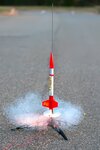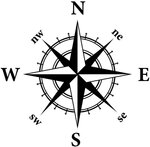

Most of us who grew up in the 50’s and 60’s were fascinated with rockets. From the sci-fi shows and movies, to JFK promising to put a man on the moon, it seemed like such an exciting future.
Somewhere in the late 50’s model rockets became popular. They consisted of a cardboard tube and a dry fuel rocket engine. A balsa wood nose cone at the top and three or four fins on the base that you could paint to look really cool. The nose cone was attached to the main rocket body and a parachute. When the rocket engine was done burning it would ignite a charge that blew the nose cone off and a parachute allowed it to float back to earth gracefully. In theory you could repack the chute, replace the spent engine and launch it again for hours of fun. That was the point where, theory and practice parted ways.
My friend Jim Engvall was the first I remember to get into model rockets. One day in Mr. Wavra’s science class we all hiked out to the football field and set up the rocket launcher. It was a textbook launch. A lantern battery was connected to the launch button and the launch pad. A small gauge wire was folded in half and inserted into the rocket engines with alligator clamps to energize the ignitor. A second or two after the launch button was pressed a flame shot out of the tail of the rocket and away it went. Straight up until it flamed out, and then a poof of smoke and the chute deployed. It slowly drifted back to earth. Unfortunately, there was a strong wind out of the west a few hundred feet above terra firma and we all watched the rocket come back to earth and disappear somewhere to the east of the rail road tracks, at least a half mile from where we were standing. Mitch Frederick and I got permission to take the next hour, which was our study hall, to go looking for the wayward rocket. We never found it but we did get to skip an hour of school, so that was a definite plus for us.
I was hooked so I ordered some model rocket kits and engines from Estes Model Rocket company in Colorado. They had a great catalog of every style of rocket one could imagine. This was the year of the moon landing and they sold a great Saturn V rocket, complete with three stages. At halftime during a bowl game at the Houston Astrodome on December 31, 1969 they launched one of these in front of a sold-out college football crowd. It was perfect, the rocket performed flawlessly and deployed the chute right under the top of the dome, slowly returning to earth buoyed by the parachute.
My mother wasn’t quite as keen to the idea of me launching rockets though. I built and painted the rockets and stored them in my bedroom. Most of my rockets were single use, never surviving their maiden flight. I recall we found one hanging from a tree in the wood while we were squirrel hunting in the fall. My mom finally told me I had to store the rocket engines outside in the farm shop. I guess she had trepidation about me storing rocket fuel in my bedroom.
So, one day my friend Gary Runner was over and we were thinking up things to do for fun. Launching a rocket seemed like the thing to do. We thought if we launched it out in the field, we could avoid any trees on re-entry. But we discovered that model rocket engines were sensitive to humidity in the farm shop and the little lantern battery would not ignite the engine. So, I got the John Deere with a 24volt battery system and enough amps to fry anything. We stuck a 17gauge electric fence wire into the engine and connected directly to the tractor battery terminals. Model rocket engines which have been impacted by moisture do not burn as uniformly as intended and when that bird took off it was not tracking the way I expected. In fact, before it got fifty feet in the air the rocket made and arc and headed back toward us like a boomerang. Gary and I dove for cover. The rocket hit the dirt and burned out before our eyes. My space dreams were crushed and I figured it would be safer if I stuck with farming.